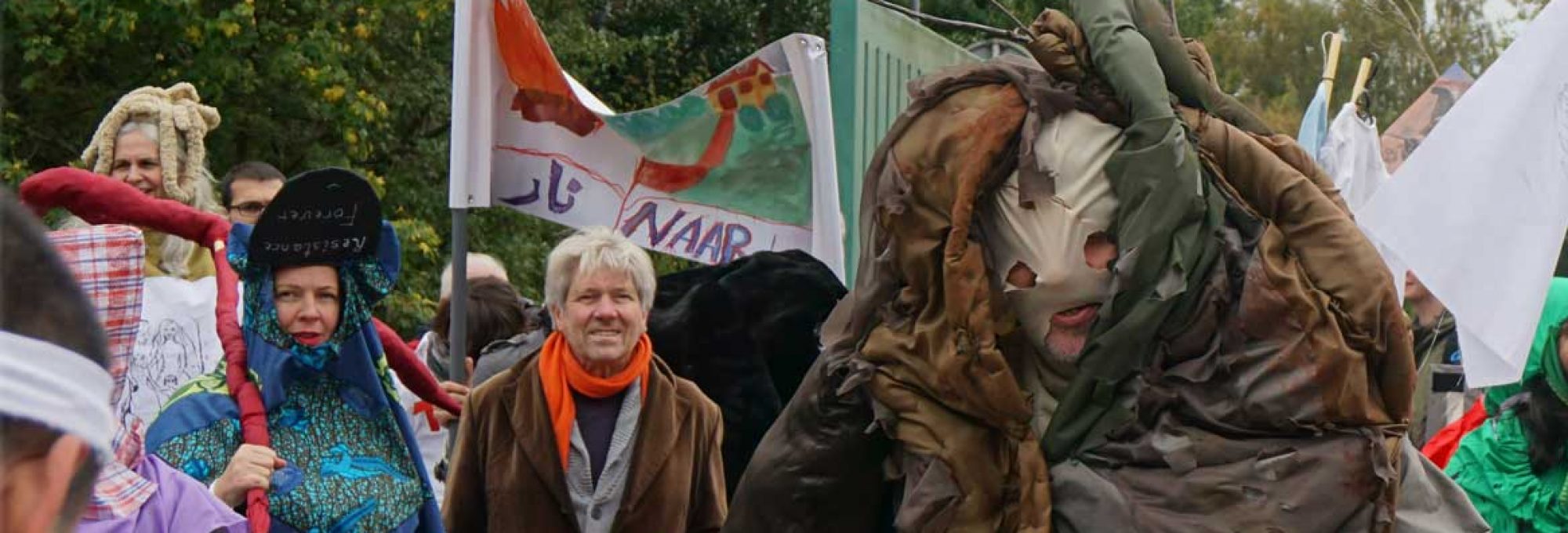contemporary art action
Bound together by one thread
Gluklya and Tsaplya’s final performance
In the Moscow museum of modern art at Petrovka 25, Petersburg artists Gluklya (Natalya Pershina-Yakimanskaya) and Tsaplya (Olga Yegorova) presented a performance piece with the multilayered title “Final Cut”: it signifies simultaneously the final edit, the final wound, and a definitive separation, not to mention the title of a Pink Floyd album which in fact coincided with the beginning of the group’s dissolution. The performance symbolized the end of an artistic partnership of many years’ standing: henceforth the “Factory of found clothes” (FFC) will be Gluklya’s solo project, while Tsaplya will be a full-time participant in the work collective “Chto delat.”
By ANNA TOLSTOVA.
The lights went out, and on the wall of the big auditorium flashed images from “Notes to an ideal beloved” (1996): in one of the first videos by the “Factory of found clothes” (FFC) two romantic and yet comical young ladies – Gluklya (Natalya Pershina-Yakimanskaya) and Tsaplya (Olga Yegorova) – ruthlessly tear their old dresses as if tearing up old allegiances, and tragically perish in their search for new love. Next, the two artists appeared on stage and the action began: those present, including friends of the FFC, painters, poets, scholars, activists, students of the Chto Delat? School of Engaged Art and spectators, found themselves literally interwoven in the piece. Stage assistants gradually unwound a cord from an enormous spool (a filiferous ribbon coil from the workshop of Gluklya’s mother, a textile artist; the “Factory” began in that workshop), weaving the participants in the performance and the audience together with it. Each of the participants told a story of love and separation, some true, some confessional, some fictional; the poet Aleksandr Skidan read a hybrid composition, part essay, part prose poem about Marguerite Duras and Yann Andréa, while Moscow Bienniale commissar Iosif Bakstein, who happened to be tied to Karina Karaeva, curator of the recent FFC exhibiton in Moscow, “Utopian unions,” performed an improvisation, albeit so skillfully that nobody guessed that the appearance of this gray cardinal of contemporary art was unplanned. And that was a typical feature of the ethics and poetics of FFC: not dividing people into “us” and “them,” “pure” and “corrupt,” involved or not involved. When the thread ran out, the difference between the artists and the audience could no longer be felt, all had become part of a gigantic spider’s web, a kind of artistic model of humanity. And then the thread was cut to the sounds of Slavist Jonathan Platt’s performance of heart-rending romance-collage of American songs from the 1950s, accompanying himself on the ukulele. Gluklya and Tsaplya, freed from their fetters, embraced and bid each other farewell. In recent times, Tsaplya has not been participating in FFC projects, being busy with work for Chto delat?—the performance “Final Cut” symbolically signified that the co-creators of the “Factory of found clothes” are separating.
The history of contemporary art has witnessed many powerful moments of separation, including that of Marina Abramović and Ulay, who walked towards each other from opposite ends of the Great Wall of China over the course of several months before saying goodbye forever. The history of FFC began in 1995 with another very powerful moment, the performance “In Memory of Poor Liza,” in which Gluklya and Tsaplya, wearing white dresses, jumped off the Hermitage bridge into the Winter Canal. “In Memory of Poor Liza” even made it into the TV news, as the headline story, making a much bigger impression than it would have as a “cultural” story. In any case, the image stayed in the memory of the narrator of contemporary author Aleksandr Ilyanen’s “The Road to U.” “The performance is dedicated to everyone who knows love’s torment,” Gluklya and Tsaplya said. The farewell may have been less heroic, but the dedication applies to it as well, as it does to their entire cooperative effort over nearly twenty years.
A perfectly ordinary item of clothing—the sort of flimsy, throwaway, worthless, laughable and unserious material that FFC has worked with in their performances, video, and installations—was interpreted as a kind of panhuman universal, growing out of everyday life and into culture. A piece of clothing is both a preserver of the body’s memory and intimate experiences, and a chronicle of the life of an ordinary human being, and a record of cultural and subcultural codes, and a political manifesto, and an instrument of resistance against gender and social stereotypes. But perhaps most importantly, for anyone who wears it, whether artistic or remote from ideas of art, clothing becomes the empty sack in which his or her creative potential is daily realized in some form or other. And FFC, partly collecting and partly simulating a second-hand archive of such clothes stories, is becoming, in its artistic-therapeutic practices, a consistent standard-bearer for Beuys’s maxim that “Everyone is an artist.” As is well known, Russian literature came out from Gogol’s “Overcoat”—FFC has acted in the shadow of that overcoat, with the slogan “The place of the artist is by the side of the weak” on their lips, getting people from all different kinds of creative professions involved in their artistic production circle, as well as retirees, soldiers, LGBT activists, migrants, and all those who have been insulted and humiliated, but whose spirit has not yet been broken. Although Gluklya and Tsaplya have gone their separate ways, we would like to believe that the “Factory of found clothes” will not stop producing meaning.
